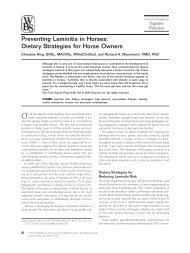Nutritional Secondary Hyperparathyroidism in the Horse
Nutritional Secondary Hyperparathyroidism in the Horse
Nutritional Secondary Hyperparathyroidism in the Horse
Create successful ePaper yourself
Turn your PDF publications into a flip-book with our unique Google optimized e-Paper software.
72 Expcrimcntal <strong>Nutritional</strong> Sccondary Hypcrparathyroidism <strong>in</strong> <strong>the</strong> <strong>Horse</strong>. . .<br />
It would seem, <strong>the</strong>refore, that an <strong>in</strong>verse relationship between<br />
calcium and phosphorus should not exist. An experiment by MCLEAN<br />
et al. (1946) offered <strong>the</strong> explanation. They <strong>in</strong>troduced <strong>the</strong> term “biological<br />
solubility” and def<strong>in</strong>ed undersaturation, saturation, and supersaturation<br />
of calcium and phosphorus <strong>in</strong> blood serum on <strong>the</strong> basis of<br />
this term. “The limit of biological solubility is <strong>the</strong> po<strong>in</strong>t at which<br />
deposition of <strong>the</strong> bone salt just occurs <strong>in</strong> <strong>the</strong> matrix of rachitic cartilage<br />
<strong>in</strong> vitro.” Levels above this po<strong>in</strong>t were considered supersaturated and<br />
below this level undersaturated. MCLEAN et al. performed <strong>the</strong> follow<strong>in</strong>g<br />
experiment: Adult dogs whose serum did not m<strong>in</strong>eralize rachitic<br />
cartilage <strong>in</strong> vitro were given a large dose of parathormone at 0 and at<br />
4 hours. The serum calcium rose rapidly and leached maximum level<br />
after 12 hours. A concurrent but slight rise <strong>in</strong> <strong>the</strong> serum phosphorus<br />
level was also recorded. At 4 hours <strong>the</strong> serum <strong>in</strong>duced a slight m<strong>in</strong>eralization<br />
of rachitic cartilage <strong>in</strong> vitro. After 8 hours <strong>the</strong> ion product of<br />
calcium and phosphorus of blood serum and <strong>in</strong> vitro m<strong>in</strong>eralization<br />
tendency was still higher. They concluded, <strong>the</strong>n, that at 4 hours <strong>the</strong><br />
serum must have been at least saturated and, after 8 hours, supersaturated.<br />
Accord<strong>in</strong>g to <strong>the</strong>se authors, <strong>the</strong> cause of supersaturation<br />
must be sought <strong>in</strong> <strong>the</strong> active <strong>in</strong>tervention by <strong>the</strong> parathyroid hormone<br />
because “<strong>the</strong>re is no way <strong>in</strong> which a solution of a salt, <strong>in</strong> contact with<br />
a solid phase, may become supersaturated by simple equilibrium with<br />
<strong>the</strong> solid”.<br />
The reports just mentioned concerned <strong>the</strong> <strong>in</strong>terrelationship<br />
between calcium and phosphorus <strong>in</strong> noncompensatory, exogenous<br />
hyperparathyroidism. The results <strong>in</strong>dicate, <strong>the</strong>refore, <strong>the</strong> effects of <strong>the</strong><br />
parathyroid hormone on serum calcium and phosphorus. The <strong>in</strong>terrelationship<br />
between calcium and phosphorus can be better demonstrated<br />
<strong>in</strong> <strong>the</strong> reverse condition, viz., <strong>the</strong> effect of different levels of<br />
serum calcium and phosphorus on <strong>the</strong> parathyroid glands. HAM et al.<br />
(1 940) showed conclusively that “hypocalcemia, <strong>in</strong>stead of hyperphosphatemia,<br />
is <strong>the</strong> primary cause of physiological hypertrophy of<br />
<strong>the</strong> parathyroid glands”. Their results were confirmed by PATT and<br />
LUCKIIARUT (1942), STOERK and CARNES (1945), and EWGFELDT et al.<br />
(1954). Different ways have been employed to produce hypocalcemia<br />
lead<strong>in</strong>g to secondary hyperparathyroidism. I-IAM et al. simply underfed<br />
calcium to <strong>in</strong>duce hypocalcemia, PATT and LUCKHARUT lowered serum<br />
calcium by <strong>in</strong>travenous <strong>in</strong>jections of sodium oxalate, and COPP et al.<br />
(1962) used EDTA <strong>in</strong>jections. With all <strong>the</strong>se methods serum calcium<br />
alone was <strong>in</strong>fluenced, and regardless of <strong>the</strong> method <strong>the</strong> result was, as far<br />
Downloaded from<br />
vet.sagepub.com by guest on April 14, 2010



